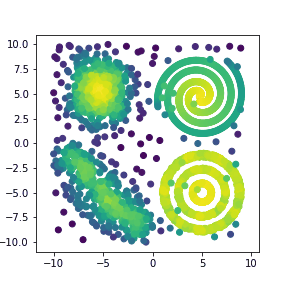This repository contains the implementation code for paper:
GIT: Clustering Based on Graph of Intensity Topology
Accuracy, Robustness to noises and scales, Interpretability, Speed, and Easy to use (ARISE) are crucial requirements of a good clustering algorithm. However, achieving these goals simultaneously is challenging, and most advanced approaches only focus on parts of them.
Towards an overall consideration of these aspects, we propose a novel clustering algo rithm, namely GIT (Clustering Based on Graph of Intensity Topology). GIT considers both local and global data structures: firstly forming local clusters based on intensity peaks of samples, and then estimating the global topological graph (topo-graph) between these local clusters. We use the Wasserstein Distance between the predicted and prior class proportions to automatically cut noisy edges in the topo-graph and merge connected local clusters as final clusters. Then, we compare GIT with seven competing algorithms on five synthetic datasets and nine real-world datasets.
The pipeline is shown as below:
We show the process of clustering on toy datasets as follows:
git_cluster/contains the core algorithm.dataloaders/contains dataloader classes for different datasets.utils/includes measurements and plot tools for understanding clustering 150.1-Accuracy/...2-Speed/...3-Robustness/...5-Dimension_reduction/...
Install the latest version from the GitHub repository via:
pip install git+https://github.com/gaozhangyang/GIT
Build setup.py and install GIT:
python setup.py build
python setup.py install
Try to import the package:
from git_cluster import GIT
We have provided quick_start.ipynb as an example, and users can refer this notebook.
We first read the data through toy_dataloader:
from dataloaders import Toy_DataLoader as DataLoader
X, Y_true = Dataloader(name='circles).load()
Then, build GIT class and choose decent hyperparameters k:
from git_cluster import GIT
git = GIT(k=10)
The predicted results are available through fit method.
Y_pred = git.fit_predict(X)
- python >= 3.7
- hdbscan == 0.8.26
- pandas==1.3.4
- plotly==5.3.1
- scikit-learn==0.23.2
- scipy==1.7.1
- numpy==1.20.0
- pydpc==0.1.3
(1) We have provided an environment setting file of conda. Users can easily reproduce the environment by the following commands:
conda env create -f environment.yml
conda activate git_cluster
(2) We compare our method with various clustering methods, among which Quichshift++, DPA, Spectacl require an extra installation. Users should follows the usages from their official github repositories.
We recommend users run the following commands:
- To install Quichshift++:
pip install git+https://github.com/google/quickshift
- To install DPA:
pip install git+https://github.com/mariaderrico/DPA
- To install Spectacl:
pip install git+https://bitbucket.org/Sibylse/spectacl/src/master/
(3) Open the jupyter notebooks in 1-Accuracy, 2-Speed, 3-Robustness, 5-Dimension_reduction.
If you find this code or idea useful, please cite our work:
@article{gao2021git,
title={Git: Clustering Based on Graph of Intensity Topology},
author={Gao, Zhangyang and Lin, Haitao and Tan, Cheng and Wu, Lirong and Li, Stan and others},
journal={arXiv preprint arXiv:2110.01274},
year={2021}
}
If you have any questions, feel free to contact us through the following emails or Github issues.





